Black Death

Black Death

The Black Death, also known as the Great Plague or the Plague, or less commonly the Black Plague, was one of the most devastating pandemics in human history, resulting in the deaths of an estimated 75 to 200 million people in Eurasia and peaking in Europe from 1347 to 1351.[1][2][3] The bacterium Yersinia pestis, which results in several forms of plague, is believed to have been the cause.[4] The Black Death was the first major European outbreak of plague, and the second plague pandemic.[5] The plague created a number of religious, social and economic upheavals which had profound effects on the course of European history.
The Black Death is thought to have originated in the dry plains of Central Asia, where it travelled along the Silk Road, reaching Crimea by 1343.[6] From there, it was most likely carried by fleas living on the black rats that traveled on all merchant ships, spreading throughout the Mediterranean Basin and Europe.
The Black Death is estimated to have killed 30% to 60% of Europe's population.[7] In total, the plague may have reduced the world population from an estimated 450 million to 350–375 million in the 14th century.[8] It took 200 years for the world population to recover to its previous level.[9][10] The plague recurred as outbreaks in Europe until the 19th century.
Chronology
Origins of the disease
The plague disease, caused by Yersinia pestis, is enzootic (commonly present) in populations of fleas carried by ground rodents, including marmots, in various areas including Central Asia, Kurdistan, Western Asia, North India and Uganda.[11] Due to climate change in Asia, rodents began to flee the dried out grasslands to more populated areas, spreading the disease.[12] Nestorian graves dating to 1338–1339 near Issyk-Kul in Kyrgyzstan have inscriptions referring to plague and are thought by many epidemiologists to mark the outbreak of the epidemic, from which it could easily have spread to China and India.[13] In October 2010, medical geneticists suggested that all three of the great waves of the plague originated in China.[14]
The 13th-century Mongol conquest of China caused a decline in farming and trading. However, economic recovery had been observed at the beginning of the fourteenth century. In the 1330s, a large number of natural disasters and plagues led to widespread famine, starting in 1331, with a deadly plague arriving soon after.[15] Epidemics that may have included plague killed an estimated 25 million Chinese and other Asians during the fifteen years before it reached Constantinople in 1347.[16][17]
The disease may have travelled along the Silk Road with Mongol armies and traders or it could have come via ship.[18] By the end of 1346, reports of plague had reached the seaports of Europe: "India was depopulated, Tartary, Mesopotamia, Syria, Armenia were covered with dead bodies".[19]
Plague was reportedly first introduced to Europe via Genoese traders from the port city of Kaffa in the Crimea in 1347.[20][21] During a protracted siege of the city by the Mongol army under Jani Beg, whose army was suffering from the disease, the army catapulted infected corpses over the city walls of Kaffa to infect the inhabitants. The Genoese traders fled, taking the plague by ship into Sicily and the south of Europe, whence it spread north.[22] Whether or not this hypothesis is accurate, it is clear that several existing conditions such as war, famine, and weather contributed to the severity of the Black Death.
European outbreak
The seventh year after it began, it came to England and first began in the towns and ports joining on the seacoasts, in Dorsetshire, where, as in other counties, it made the country quite void of inhabitants so that there were almost none left alive.... But at length it came to Gloucester, yea even to Oxford and to London, and finally it spread over all England and so wasted the people that scarce the tenth person of any sort was left alive. Geoffrey the Baker, Chronicon Angliae
There appear to have been several introductions into Europe. The plague reached Sicily in October 1347, carried by twelve Genoese galleys,[23] and rapidly spread all over the island. Galleys from Kaffa reached Genoa and Venice in January 1348, but it was the outbreak in Pisa a few weeks later that was the entry point to northern Italy. Towards the end of January, one of the galleys expelled from Italy arrived in Marseille.[24]
From Italy, the disease spread northwest across Europe, striking France, Spain, Portugal and England by June 1348, then turned and spread east and north through Germany, Scotland and Scandinavia from 1348 to 1350. It was introduced in Norway in 1349 when a ship landed at Askøy, then spread to Bjørgvin (modern Bergen) and Iceland.[25] Finally it spread to northwestern Russia in 1351. The plague was somewhat less common in parts of Europe that had smaller trade relations with their neighbours, including the majority of the Basque Country, isolated parts of Belgium and the Netherlands, and isolated alpine villages throughout the continent.[26][27]
Modern researchers do not think that the plague ever became endemic in Europe or its rat population. The disease repeatedly wiped out the rodent carriers so that the fleas died out until a new outbreak from Central Asia repeated the process. The outbreaks have been shown to occur roughly 15 years after a warmer and wetter period in areas where plague is endemic in other species such as gerbils.[28][29]
Middle Eastern outbreak
The plague struck various regions in the Middle East during the pandemic, leading to serious depopulation and permanent change in both economic and social structures. It spread from China with the Mongols to a trading post in Crimea, called Kaffa, controlled by the Republic of Genoa. As infected rodents infected new rodents, the disease spread across the region, entering also from southern Russia. By autumn 1347, the plague reached Alexandria in Egypt, through the port's trade with Constantinople, and ports on the Black Sea. During 1347, the disease travelled eastward to Gaza, and north along the eastern coast to cities in Lebanon, Syria and Palestine, including Ashkelon, Acre, Jerusalem, Sidon, Damascus, Homs, and Aleppo. In 1348–1349, the disease reached Antioch. The city's residents fled to the north, but most of them ended up dying during the journey.[30]
Signs and symptoms

A hand showing how acral gangrene of the fingers due to bubonic plague causes the skin and flesh to die and turn black
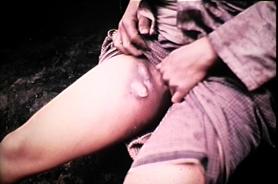
An inguinal bubo on the upper thigh of a person infected with bubonic plague. Swollen lymph glands (buboes) often occur in the neck, armpit and groin (inguinal) regions of plague victims.
Contemporary accounts of the plague are often varied or imprecise. The most commonly noted symptom was the appearance of buboes (or gavocciolos) in the groin, the neck and armpits, which oozed pus and bled when opened.[31] Boccaccio's description:
In men and women alike it first betrayed itself by the emergence of certain tumours in the groin or armpits, some of which grew as large as a common apple, others as an egg ... From the two said parts of the body this deadly gavocciolo soon began to propagate and spread itself in all directions indifferently; after which the form of the malady began to change, black spots or livid making their appearance in many cases on the arm or the thigh or elsewhere, now few and large, now minute and numerous. As the gavocciolo had been and still was an infallible token of approaching death, such also were these spots on whomsoever they showed themselves.[32]
The only medical detail that is questionable in Boccaccio's description is that the gavocciolo was an "infallible token of approaching death", as, if the bubo discharges, recovery is possible.[33]
This was followed by acute fever and vomiting of blood. Most victims died two to seven days after initial infection. Freckle-like spots and rashes,[34] which could have been caused by flea-bites, were identified as another potential sign of the plague.
Some accounts, like that of Lodewijk Heyligen, whose master the Cardinal Colonna died of the plague in 1348, noted a distinct form of the disease that infected the lungs and led to respiratory problems[31] and is identified with pneumonic plague.
It is said that the plague takes three forms. In the first people suffer an infection of the lungs, which leads to breathing difficulties. Whoever has this corruption or contamination to any extent cannot escape but will die within two days. Another form ... in which boils erupt under the armpits, ... a third form in which people of both sexes are attacked in the groin.[35]
Causes

Oriental rat flea (Xenopsylla cheopis) infected with the Yersinia pestis bacterium which appears as a dark mass in the gut. The foregut (proventriculus) of this flea is blocked by a Y. pestis biofilm; when the flea attempts to feed on an uninfected host Y. pestis is regurgitated into the wound, causing infection.

The Oriental rat flea (Xenopsylla cheopis) engorged with blood. This species of flea is the primary vector for the transmission of Yersinia pestis, the organism responsible for spreading bubonic plague in most plague epidemics. Both male and female fleas feed on blood and can transmit the infection.

Yersinia pestis (200x magnification), the bacterium which causes bubonic plague[36]
Medical knowledge had stagnated during the Middle Ages. The most authoritative account at the time came from the medical faculty in Paris in a report to the king of France that blamed the heavens, in the form of a conjunction of three planets in 1345 that caused a "great pestilence in the air".[37] This report became the first and most widely circulated of a series of plague tracts that sought to give advice to sufferers. That the plague was caused by bad air became the most widely accepted theory. Today, this is known as the miasma theory. The word plague had no special significance at this time, and only the recurrence of outbreaks during the Middle Ages gave it the name that has become the medical term.
The importance of hygiene was recognised only in the nineteenth century; until then it was common that the streets were filthy, with live animals of all sorts around and human parasites abounding. A transmissible disease will spread easily in such conditions. One development as a result of the Black Death was the establishment of the idea of quarantine in the city-state of Ragusa (modern Dubrovnik, Croatia) in 1377 after continuing outbreaks.[38]
The dominant explanation for the Black Death is the plague theory, which attributes the outbreak to Yersinia pestis, also responsible for an epidemic that began in southern China in 1865, eventually spreading to India. The investigation of the pathogen that caused the 19th-century plague was begun by teams of scientists who visited Hong Kong in 1894, among whom was the French-Swiss bacteriologist Alexandre Yersin, after whom the pathogen was named.[39] The mechanism by which Y. pestis was usually transmitted was established in 1898 by Paul-Louis Simond and was found to involve the bites of fleas whose midguts had become obstructed by replicating Y. pestis several days after feeding on an infected host. This blockage results in starvation and aggressive feeding behaviour by the fleas, which repeatedly attempt to clear their blockage by regurgitation, resulting in thousands of plague bacteria being flushed into the feeding site, infecting the host. The bubonic plague mechanism was also dependent on two populations of rodents: one resistant to the disease, which act as hosts, keeping the disease endemic, and a second that lack resistance. When the second population dies, the fleas move on to other hosts, including people, thus creating a human epidemic.[39]
The historian Francis Aidan Gasquet wrote about the Great Pestilence in 1893[40] and suggested that "it would appear to be some form of the ordinary Eastern or bubonic plague". He was able to adopt the epidemiology of the bubonic plague for the Black Death for the second edition in 1908, implicating rats and fleas in the process, and his interpretation was widely accepted for other ancient and medieval epidemics, such as the Justinian plague that was prevalent in the Eastern Roman Empire from 541 to 700 CE.[39]
An estimate of the mortality rate for the modern bubonic plague, following the introduction of antibiotics, is 11%, although it may be higher in underdeveloped regions.[41] Symptoms of the disease include fever of 38–41 °C (100–106 °F), headaches, painful aching joints, nausea and vomiting, and a general feeling of malaise. Left untreated, of those that contract the bubonic plague, 80 percent die within eight days.[42] Pneumonic plague has a mortality rate of 90 to 95 percent. Symptoms include fever, cough, and blood-tinged sputum. As the disease progresses, sputum becomes free-flowing and bright red. Septicemic plague is the least common of the three forms, with a mortality rate near 100%. Symptoms are high fevers and purple skin patches (purpura due to disseminated intravascular coagulation). In cases of pneumonic and particularly septicemic plague, the progress of the disease is so rapid that there would often be no time for the development of the enlarged lymph nodes that were noted as buboes.[43]
A number of alternative theories – implicating other diseases in the Black Death pandemic – have also been proposed by some modern scientists (see below – "Alternative Explanations").
DNA evidence
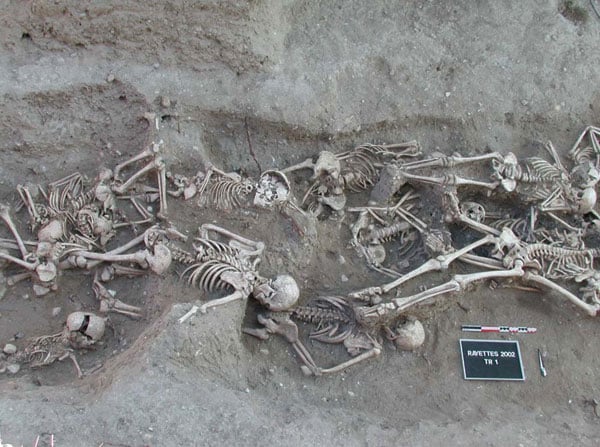
Skeletons in a mass grave from 1720–1721 in Martigues, France, yielded molecular evidence of the orientalis strain of Yersinia pestis, the organism responsible for bubonic plague. The second pandemic of bubonic plague was active in Europe from 1347, the beginning of the Black Death, until 1750.
In October 2010, the open-access scientific journal PLoS Pathogens published a paper by a multinational team who undertook a new investigation into the role of Yersinia pestis in the Black Death following the disputed identification by Drancourt and Raoult in 1998. They assessed the presence of DNA/RNA with polymerase chain reaction (PCR) techniques for Y. pestis from the tooth sockets in human skeletons from mass graves in northern, central and southern Europe that were associated archaeologically with the Black Death and subsequent resurgences. The authors concluded that this new research, together with prior analyses from the south of France and Germany,[44] "ends the debate about the cause of the Black Death, and unambiguously demonstrates that Y. pestis was the causative agent of the epidemic plague that devastated Europe during the Middle Ages".[45]
The study also found that there were two previously unknown but related clades (genetic branches) of the Y. pestis genome associated with medieval mass graves. These clades (which are thought to be extinct) were found to be ancestral to modern isolates of the modern Y. pestis strains Y. p. orientalis and Y. p. medievalis, suggesting the plague may have entered Europe in two waves. Surveys of plague pit remains in France and England indicate the first variant entered Europe through the port of Marseille around November 1347 and spread through France over the next two years, eventually reaching England in the spring of 1349, where it spread through the country in three epidemics. Surveys of plague pit remains from the Dutch town of Bergen op Zoom showed the Y. pestis genotype responsible for the pandemic that spread through the Low Countries from 1350 differed from that found in Britain and France, implying Bergen op Zoom (and possibly other parts of the southern Netherlands) was not directly infected from England or France in 1349 and suggesting a second wave of plague, different from those in Britain and France, may have been carried to the Low Countries from Norway, the Hanseatic cities or another site.[45]
The results of the Haensch study have since been confirmed and amended. Based on genetic evidence derived from Black Death victims in the East Smithfield burial site in England, Schuenemann et al. concluded in 2011 "that the Black Death in medieval Europe was caused by a variant of Y. pestis that may no longer exist."[46] A study published in Nature in October 2011 sequenced the genome of Y. pestis from plague victims and indicated that the strain that caused the Black Death is ancestral to most modern strains of the disease.[47]
Alternative explanations

Anthrax skin lesion
The plague theory was first significantly challenged by the work of British bacteriologist J. F. D. Shrewsbury in 1970, who noted that the reported rates of mortality in rural areas during the 14th-century pandemic were inconsistent with the modern bubonic plague, leading him to conclude that contemporary accounts were exaggerations.[39] In 1984, zoologist Graham Twigg produced the first major work to challenge the bubonic plague theory directly, and his doubts about the identity of the Black Death have been taken up by a number of authors, including Samuel K. Cohn, Jr. (2002 and 2013), David Herlihy (1997), and Susan Scott and Christopher Duncan (2001).[39]
It is recognised that an epidemiological account of the plague is as important as an identification of symptoms, but researchers are hampered by the lack of reliable statistics from this period. Most work has been done on the spread of the plague in England, and even estimates of overall population at the start vary by over 100% as no census was undertaken between the time of publication of the Domesday Book and the year 1377.[50] Estimates of plague victims are usually extrapolated from figures from the clergy.
In addition to arguing that the rat population was insufficient to account for a bubonic plague pandemic, sceptics of the bubonic plague theory point out that the symptoms of the Black Death are not unique (and arguably in some accounts may differ from bubonic plague); that transference via fleas in goods was likely to be of marginal significance; and that the DNA results may be flawed and might not have been repeated elsewhere or were not replicable at all, despite extensive samples from other mass graves.[39] Other arguments include the lack of accounts of the death of rats before outbreaks of plague between the 14th and 17th centuries; temperatures that are too cold in northern Europe for the survival of fleas; that, despite primitive transport systems, the spread of the Black Death was much faster than that of modern bubonic plague; that mortality rates of the Black Death appear to be very high; that, while modern bubonic plague is largely endemic as a rural disease, the Black Death indiscriminately struck urban and rural areas; and that the pattern of the Black Death, with major outbreaks in the same areas separated by 5 to 15 years, differs from modern bubonic plague—which often becomes endemic for decades with annual flare-ups.[39]
McCormick has suggested that earlier archaeologists were simply not interested in the "laborious" processes needed to discover rat remains.[51] Walløe complains that all of these authors "take it for granted that Simond's infection model, black rat → rat flea → human, which was developed to explain the spread of plague in India, is the only way an epidemic of Yersinia pestis infection could spread", whilst pointing to several other possibilities.[52] Similarly, Green has argued that greater attention is needed to the range of (especially non-commensal) animals that might be involved in the transmission of plague.[53]
A variety of alternatives to Y. pestis have been put forward. Twigg suggested that the cause was a form of anthrax, and Norman Cantor thought it may have been a combination of anthrax and other pandemics. Scott and Duncan have argued that the pandemic was a form of infectious disease that they characterise as hemorrhagic plague similar to Ebola. Archaeologist Barney Sloane has argued that there is insufficient evidence of the extinction of a large number of rats in the archaeological record of the medieval waterfront in London and that the plague spread too quickly to support the thesis that Y. pestis was spread from fleas on rats; he argues that transmission must have been person to person.[54][55] This theory is supported by research in 2018 which suggested transmission was more likely by body lice and human fleas during the second plague pandemic.[56]
However, no single alternative solution has achieved widespread acceptance.[39] Many scholars arguing for Y. pestis as the major agent of the pandemic suggest that its extent and symptoms can be explained by a combination of bubonic plague with other diseases, including typhus, smallpox and respiratory infections. In addition to the bubonic infection, others point to additional septicemic (a type of "blood poisoning") and pneumonic (an airborne plague that attacks the lungs before the rest of the body) forms of the plague, which lengthen the duration of outbreaks throughout the seasons and help account for its high mortality rate and additional recorded symptoms.[31] In 2014, Public Health England announced the results of an examination of 25 bodies exhumed in the Clerkenwell area of London, as well as of wills registered in London during the period, which supported the pneumonic hypothesis.[48]
Consequences
Death toll

Citizens of Tournai bury plague victims
There are no exact figures for the death toll; the rate varied widely by locality. In urban centres, the greater the population before the outbreak, the longer the duration of the period of abnormal mortality.[57] It killed some 75 to 200 million people in Eurasia.[1][58][3] According to medieval historian Philip Daileader in 2007:
The trend of recent research is pointing to a figure more like 45–50% of the European population dying during a four-year period. There is a fair amount of geographic variation. In Mediterranean Europe, areas such as Italy, the south of France and Spain, where plague ran for about four years consecutively, it was probably closer to 75–80% of the population. In Germany and England ... it was probably closer to 20%.[59]
A death rate as high as 60% in Europe has been suggested by Norwegian historian Ole Benedictow:
Detailed study of the mortality data available points to two conspicuous features in relation to the mortality caused by the Black Death: namely the extreme level of mortality caused by the Black Death, and the remarkable similarity or consistency of the level of mortality, from Spain in southern Europe to England in north-western Europe. The data is sufficiently widespread and numerous to make it likely that the Black Death swept away around 60 per cent of Europe's population. It is generally assumed that the size of Europe's population at the time was around 80 million. This implies that around 50 million people died in the Black Death.[60]
The most widely accepted estimate for the Middle East, including Iraq, Iran and Syria, during this time, is for a death rate of about a third.[61] The Black Death killed about 40% of Egypt's population.[62] Half of Paris's population of 100,000 people died. In Italy, the population of Florence was reduced from 110,000–120,000 inhabitants in 1338 down to 50,000 in 1351. At least 60% of the population of Hamburg and Bremen perished,[63] and a similar percentage of Londoners may have died from the disease as well.[48] In London approximately 62,000 people died between 1346 and 1353.[12] While contemporary reports account of mass burial pits being created in response to the large numbers of dead, recent scientific investigations of a burial pit in Central London found well-preserved individuals to be buried in isolated, evenly spaced graves, suggesting at least some pre-planning and Christian burials at this time.[64] Before 1350, there were about 170,000 settlements in Germany, and this was reduced by nearly 40,000 by 1450.[65] In 1348, the plague spread so rapidly that before any physicians or government authorities had time to reflect upon its origins, about a third of the European population had already perished. In crowded cities, it was not uncommon for as much as 50% of the population to die.[39] The disease bypassed some areas, and the most isolated areas were less vulnerable to contagion. Monks, nuns and priests were especially hard-hit since they cared for victims of the Black Death.[66]
Economic
With such a massive depopulation from the Plague, wages soared in response to a labor shortage.[67]
Persecutions

Inspired by the Black Death, The Dance of Death, or Danse Macabre, an allegory on the universality of death, was a common painting motif in the late medieval period.
Renewed religious fervour and fanaticism bloomed in the wake of the Black Death. Some Europeans targeted "various groups such as Jews, friars, foreigners, beggars, pilgrims",[68] lepers,[68][69] and Romani, thinking that they were to blame for the crisis. Lepers, and other individuals with skin diseases such as acne or psoriasis, were singled out and exterminated throughout Europe.
Because 14th-century healers were at a loss to explain the cause, Europeans turned to astrological forces, earthquakes, and the poisoning of wells by Jews as possible reasons for the plague's emergence.[70] The governments of Europe had no apparent response to the crisis because no one knew its cause or how it spread. The mechanism of infection and transmission of diseases was little understood in the 14th century; many people believed the epidemic was a punishment by God for their sins. This belief led to the idea that the cure to the disease was to win God's forgiveness.[71]
There were many attacks against Jewish communities.[72] In the Strasbourg massacre of February 1349, about 2,000 Jews were murdered.[72] In August 1349, the Jewish communities in Mainz and Cologne were annihilated. By 1351, 60 major and 150 smaller Jewish communities had been destroyed.[73] These massacres eventually died out in Western Europe, only to continue on in Eastern Europe. During this period many Jews relocated to Poland, where they received a warm welcome from King Casimir the Great.[74]
Recurrence
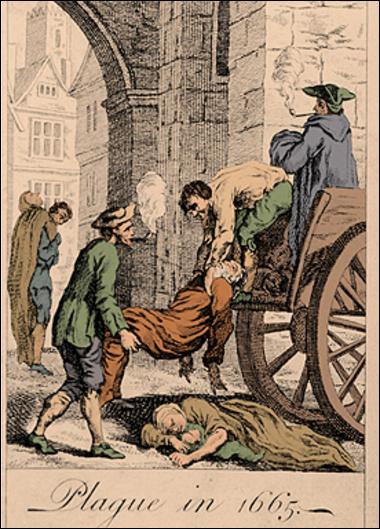
The Great Plague of London, in 1665, killed up to 100,000 people.
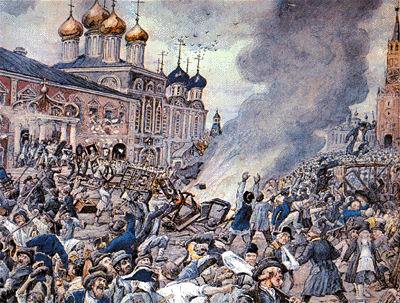
Plague Riot in Moscow in 1771: during the course of the city's plague, between 50,000 and 100,000 people died, 17–33% of its population.
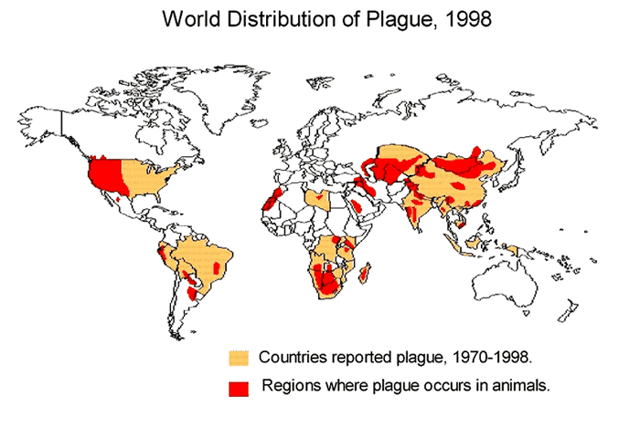
Worldwide distribution of plague-infected animals, 1998
The plague repeatedly returned to haunt Europe and the Mediterranean throughout the 14th to 17th centuries.[75] According to Biraben, the plague was present somewhere in Europe in every year between 1346 and 1671.[76] The Second Pandemic was particularly widespread in the following years: 1360–1363; 1374; 1400; 1438–1439; 1456–1457; 1464–1466; 1481–1485; 1500–1503; 1518–1531; 1544–1548; 1563–1566; 1573–1588; 1596–1599; 1602–1611; 1623–1640; 1644–1654; and 1664–1667. Subsequent outbreaks, though severe, marked the retreat from most of Europe (18th century) and northern Africa (19th century).[77] According to Geoffrey Parker, "France alone lost almost a million people to the plague in the epidemic of 1628–31."[78]
In England, in the absence of census figures, historians propose a range of pre-incident population figures from as high as 7 million to as low as 4 million in 1300,[79] and a post-incident population figure as low as 2 million.[80] By the end of 1350, the Black Death subsided, but it never really died out in England. Over the next few hundred years, further outbreaks occurred in 1361–1362, 1369, 1379–1383, 1389–1393, and throughout the first half of the 15th century.[81] An outbreak in 1471 took as much as 10–15% of the population, while the death rate of the plague of 1479–1480 could have been as high as 20%.[82] The most general outbreaks in Tudor and Stuart England seem to have begun in 1498, 1535, 1543, 1563, 1589, 1603, 1625, and 1636, and ended with the Great Plague of London in 1665.[83]
In 1466, perhaps 40,000 people died of the plague in Paris.[84] During the 16th and 17th centuries, the plague was present in Paris around 30 per cent of the time.[85] The Black Death ravaged Europe for three years before it continued on into Russia, where the disease was present somewhere in the country 25 times between 1350 and 1490.[86] Plague epidemics ravaged London in 1563, 1593, 1603, 1625, 1636, and 1665,[87] reducing its population by 10 to 30% during those years.[88] Over 10% of Amsterdam's population died in 1623–1625, and again in 1635–1636, 1655, and 1664.[89] Plague occurred in Venice 22 times between 1361 and 1528.[90] The plague of 1576–1577 killed 50,000 in Venice, almost a third of the population.[91] Late outbreaks in central Europe included the Italian Plague of 1629–1631, which is associated with troop movements during the Thirty Years' War, and the Great Plague of Vienna in 1679. Over 60% of Norway's population died in 1348–1350.[92] The last plague outbreak ravaged Oslo in 1654.[93]
In the first half of the 17th century, a plague claimed some 1.7 million victims in Italy, or about 14% of the population.[94] In 1656, the plague killed about half of Naples' 300,000 inhabitants.[95] More than 1.25 million deaths resulted from the extreme incidence of plague in 17th-century Spain.[96] The plague of 1649 probably reduced the population of Seville by half.[97] In 1709–1713, a plague epidemic that followed the Great Northern War (1700–1721, Sweden v. Russia and allies)[98] killed about 100,000 in Sweden,[99] and 300,000 in Prussia.[97] The plague killed two-thirds of the inhabitants of Helsinki,[100] and claimed a third of Stockholm's population.[101] Europe's last major epidemic occurred in 1720 in Marseille.[92]
The Black Death ravaged much of the Islamic world.[102] Plague was present in at least one location in the Islamic world virtually every year between 1500 and 1850.[103] Plague repeatedly struck the cities of North Africa. Algiers lost 30,000–50,000 inhabitants to it in 1620–1621, and again in 1654–1657, 1665, 1691, and 1740–1742.[104] Plague remained a major event in Ottoman society until the second quarter of the 19th century. Between 1701 and 1750, thirty-seven larger and smaller epidemics were recorded in Constantinople, and an additional thirty-one between 1751 and 1800.[105] Baghdad has suffered severely from visitations of the plague, and sometimes two-thirds of its population has been wiped out.[106]
Third plague pandemic
The third plague pandemic (1855–1859) started in China in the mid-19th century, spreading to all inhabited continents and killing 10 million people in India alone.[107] Twelve plague outbreaks in Australia between 1900 and 1925 resulted in well over 1,000 deaths, chiefly in Sydney. This led to the establishment of a Public Health Department there which undertook some leading-edge research on plague transmission from rat fleas to humans via the bacillus Yersinia pestis.[108]
Modern treatment methods include insecticides, the use of antibiotics, and a plague vaccine. The plague bacterium could develop drug resistance and again become a major health threat. One case of a drug-resistant form of the bacterium was found in Madagascar in 1995.[112] A further outbreak in Madagascar was reported in November 2014.[113] In October 2017 the deadliest outbreak of the plague in modern times hit Madagascar, killing 170 people and infecting thousands.[114]
Names
The phrase "black death" (mors nigra) was used in 1350 by Simon de Covino or Couvin, a Belgian astronomer, who wrote the poem "On the Judgment of the Sun at a Feast of Saturn" (De judicio Solis in convivio Saturni), which attributes the plague to a conjunction of Jupiter and Saturn.[115] In 1908, Gasquet claimed that use of the name atra mors for the 14th-century epidemic first appeared in a 1631 book on Danish history by J. I. Pontanus: "Commonly and from its effects, they called it the black death" (Vulgo & ab effectu atram mortem vocatibant).[116] The name spread through Scandinavia and then Germany, gradually becoming attached to the mid 14th-century epidemic as a proper name.[117] However, atra mors is used to refer to a pestilential fever (febris pestilentialis) already in the 12th-century On the Signs and Symptoms of Diseases (Latin: De signis et sinthomatibus egritudinum) by French physician Gilles de Corbeil.[118] In English, the term was first used in 1755.[119][120] Writers contemporary with the plague described the event as "great plague"[70] or "great pestilence".[121]
See also
Plague of Justinian
Black Death (film)
Black Death in England
CCR5, a human gene hypothesised to be associated with the plague
Crisis of the Late Middle Ages
Cronaca fiorentina (Chronicle of Florence); a literary history of the plague, and of Florence up to 1386, by Baldassarre Bonaiuti
Danse Macabre
Death
Doomsday Book (novel), a science fiction novel written by Connie Willis
Four thieves vinegar; a popular French legend saying this recipe provided immunity to the plague
Geisslerlieder
Globalization and disease
Last outbreak of bubonic plague in England (1906–1918)
Plague doctor
Plague doctor costume
Spanish Flu
Ring a Ring o' Roses
The Seventh Seal, a film directed by Ingmar Bergman
Timeline of plague